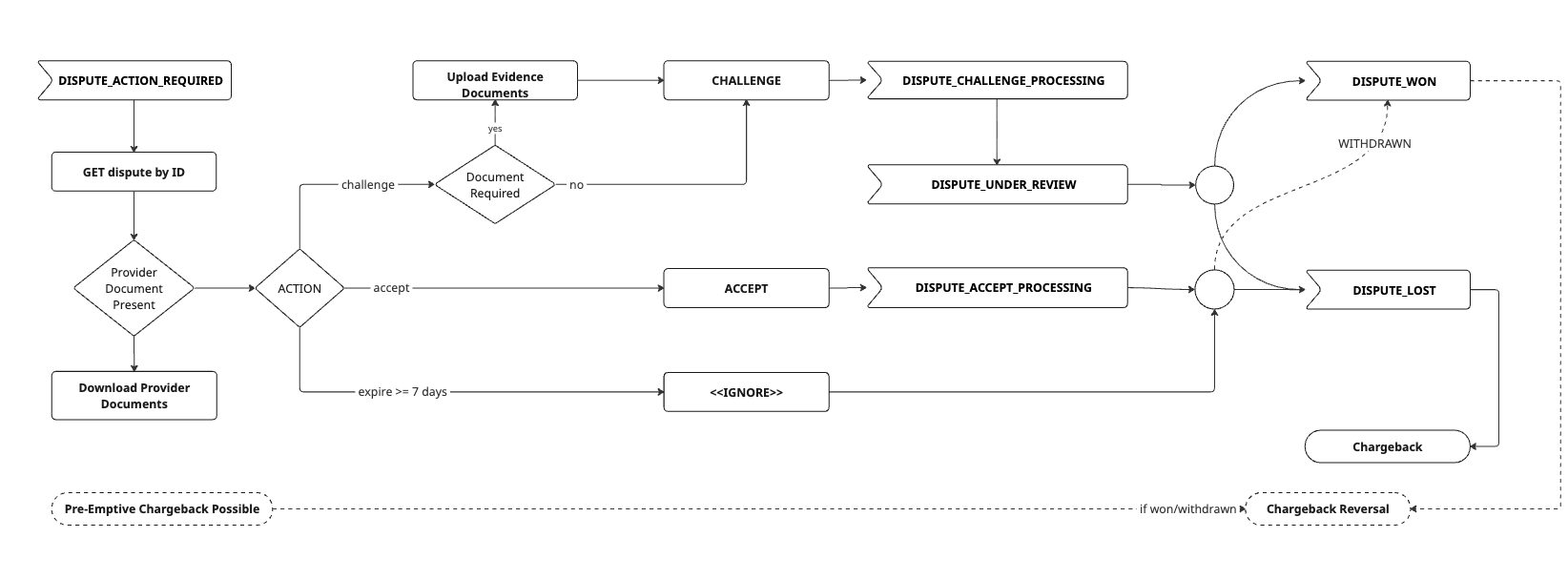Disputes resolution flow and process
This guide walks you through the dispute resolution lifecycle, from receiving initial notifications to resolving disputes through acceptance or challenge.
Dispute resolution flow

Dispute resolution process
Step 1: Receive dispute notification
When a dispute is created against a merchant account, a DISPUTE_ACTION_REQUIRED webhook notification is sent to the registered endpoint.
Step 2: Retrieve dispute details
Retrieve detailed information about a specific dispute, including the reason, status, and any consumer provided files. Full list of reason codes can be accessed here.
API endpoint: GET /v1/disputes/{disputeId}
When to use:
- Immediately after receiving
DISPUTE_ACTION_REQUIREDwebhook - To check current status of in-progress disputes
Step 3: Download provider files (if available)
Download any documentation or evidence submitted by the payment provider or consumer.
API endpoint:GET /v1/disputes/{disputeId}/files/{fileId}
The response provides:
- A time-limited download URL for secure file access
- File metadata (name, type, size)
When to use:
- After retrieving dispute details (if files are attached)
- To review consumer-submitted evidence before preparing response
Important: Not all disputes include provider-submitted files.
Step 4: Upload your supporting files
Upload supporting documentation to challenge the dispute and prove payment validity. Multiple files can be uploaded.
API endpoint: POST /v1/disputes/{disputeId}/files
File Requirements:
- Accepted formats:
PDF(other formats pending) - Maximum file size: 10MB
- Files must be readable and directly relevant to the dispute
When to use:
- When you decide to CHALLENGE a dispute
Step 5: Add messages (optional)
Communicate directly with the consumer or payment provider during the dispute resolution process by posting messages.
API endpoint: POST /v1/disputes/{disputeId}/messages
When to use:
- Direct communication with the consumer to resolve disputes amicably
- Negotiating resolution before formal challenge/acceptance
- Communicating with the provider about dispute specifics
Important: This endpoint is available only when the payment provider supports direct communication between merchants and consumers/providers.
Step 6: Accept or Challenge the dispute
Submit your final decision on how to handle the dispute.
API endpoint:POST /v1/disputes/{disputeId}/actions
Two actions available:
ACCEPTED
- You agree with the dispute
- The disputed amount is returned to the consumer.
- Dispute is closed (status:
LOST) - No evidence submission required
CHALLENGE
- The dispute is contested with evidence
- Previously uploaded evidence is submitted to provider
- Provider reviews and reaches a decision
- May result in
WIN(merchant keeps funds) orLOST(funds returned to consumer)
Important
Must respond before deadline (provided in dispute details) otherwise dispute is closed (status:
LOST)CHALLENGE requires evidence upload (Step 4) before submission
Action cannot be reversed once submitted
Step 7: Track dispute resolution
Webhook Events involved:
DISPUTE_CHALLENGE_PROCESSINGDISPUTE_UNDER_REVIEWDISPUTE_ACCEPT_PROCESSINGDISPUTE_WONDISPUTE_LOST
Possible final outcomes:
| Status | Meaning | Impact |
|---|---|---|
| WON | Provider ruled in the merchant's favor | Merchant retains funds, dispute closed. |
| LOST | Provider ruled in the consumer's favor | Funds returned to consumer, dispute closed. |
Updated 12 days ago